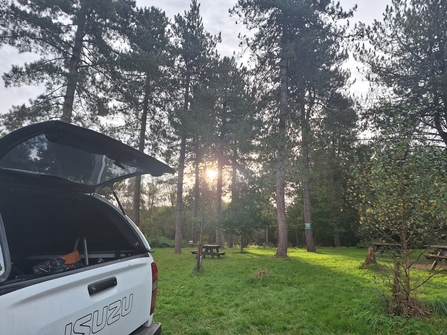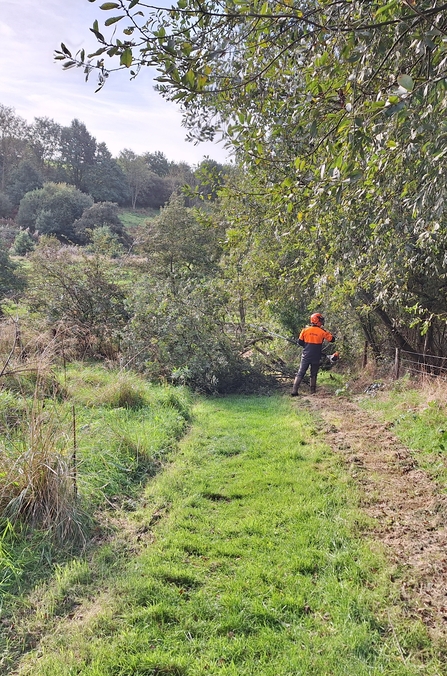
Warden's Work - Snipe Dales in October

Although it promised to be a much drier visit this time around, there was an icy wind in the air and it truly felt the site was starting to become more autumnal. Despite the cooler weather, the car park was relatively busy for first thing in the morning – people probably keen to take advantage of a rare dry day as we edge closer to winter.
When I first arrived, James informed me that the cattle had left the nature reserve, and it was strange to think that part of my day wouldn’t involve them for the first time since I started visiting Snipe Dales. James clearly felt their absence too as they had been grazing on the nature reserve since May 2022 and had been checked on every single day, including Christmas Day. But there was still plenty of work to be done and with the site shifting towards winter there was not much time to sit and dwell on changes. The water troughs needed to be cleared out to avoid the water freezing as it gets colder and ruining them. We also attached the trailer to the truck to transport some of the equipment needed for grazing, including a stock gate that would need to be fixed on at one of the reserves. I imagine it was a good time to utilise the trailer as driving it around the site is something that will only get harder as time advances and the paths get muddier.
Although there was still a wealth of green on the trees, there was a few hints of orange and the site was rich with hawthorn and holly berries. It was the biggest change to the landscape I had seen since my first visit to Snipe in July. Many of the spring and summer migrant birds I had been used to seeing in my first months of visiting Snipe Dales had departed and made way for some new winter visitors such as siskin, goldfinches and redwings making the most of the berries and seeds on trees and shrubs, as well as some goldcrests busily searching out insects and spiders on bark and twigs.

After clearing out the troughs enroute, we headed towards some willow that was hanging over the fence and blocking the path. Although there were no cattle, ponies were still grazing on the reserve and they are apparently rather fond of willow branches. This is what makes Snipe Dales work so well: rather than worrying where to put all of the branches that are cut, the site will take care of it for you as it naturally would. The ponies will forage the willow branches that are on or by their path and the rest of the willow will create a home for invertebrates in the winter.
After a morning of cutting, we headed off site to take a cattle gate (or as James expertly put ‘an articulating stock gate’) over to Sow Dale to fix it on there. The cattle that were grazing on that reserve were also being taken off site soon so it was good to get it fixed on for when they were collected. One thing James noted as we travelled around the different reserves was that seasonal agricultural work was going on around you all the time. Many fields that are joined up or very close to the reserves that James manages are owned by various farmers so even as our reserves change you see that change on the work being carried out all around you as well.
I had asked James what his experience was of his reserves in this transitional part of the year, wanting to know how he saw it as someone who sees this change every year. I wanted to include a piece that he wrote to me after my visit that I believe captures all I experienced myself very well:
“It is a strange “handover” time of year. We have concluded the cattle grazing; trying to find a balance between the benefits of tackling the coarse vegetation with the potential issues of leaving cattle on soft ground. We still have the Highland ponies, which, as the weather becomes colder, will turn their attention to some of the less desirable plants (from our point of view!) such as soft-rush. Consuming this bulky material will help the ponies stay warm. Cattle and ponies make a good team, as they graze in such different ways. It will be interesting to see if we are visited again by overwintering common snipe that probe for food in the wet margins of the streams and flushes of the grazed fields. We will turn off the water supply to troughs and protect them against frost. Another winter task will be checking the miles of stock-fences in preparation for the next grazing season.
At this time of year there is a shift in focus from grassland to woodland management. We will start our programme of felling diseased and damaged trees where necessary, as well as felling-to-waste a few of the Corsican pines to create openings and opportunities for broadleaf trees and shrubs. The dead material will continue to provide homes for invertebrates and will be recycled by fungi. Where we have to be cautious of scrub encroachment in the grassland (cutting this back is another task for winter), we will actively try to manage and maintain woodland scrub as a key component of our woodland."
I am really looking forward to experiencing more of these changes and seeing the workload shift in focus during winter. Unfortunately, only a couple of days after my visit this month, Snipe Dales was hit badly by Storm Babet and a lot of the area was severely flooded. This is something that cannot be planned into a calendar, but as a Warden managing a site like Snipe Dales you always need to be prepared for. I look forward to my next visit hearing how James managed the site against the storm and what he needed to do to combat the extreme flooding.

Snipe Dales in October

